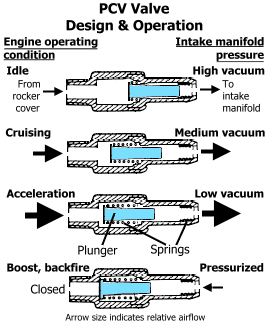Heres the problem with hoses hanging near the ground & plugging your vacuum source. When at speed, one hose will develop negative pressure, and the other positive as the hose has a venturi effect when air is moving past it. What happens then is you are sucking up dirt, sand, water, etc. directly into your valve cover & into the motor internals. I suspect they have no filter on them, correct? Also, if you are not pulling metered vacuum at idle & low RPM's the harmfull vapors that are in your crankcase cannot be pulled totally out...only pressure vents so all the unburnt fuel, caustic gasses from blow-by, & moisture will re-condense in your crankcase after the motor cools & contaminate the oil as well as corode internal parts (look at the links in another thread on bearings & see the damage just the unfiltered dust causes). A proper PCV system needs a fresh air source that is filtered, (on the stock OEM setup it is drawn from in front of the throttle body & the main air filer cleans the air pulled) and a vacum source that is metered & valved, such as the PCV valve on a LS1 or the fixed orfice & baffle system in the vally cover of the LS6 & LS2/3/7 design. The problem with the OEM systems on our vettes is it allows oil vapors to be pulled into the intake & robs power & contributes to detonation. The only proper way to correct this w/out sacrificing your engine to premature wear (I have seen motor come in that look like dirt was poured right into the crankcase & no internal part not showing advanced wear & failure from the hoses dangling unfiltered to the ground. Those that have this setup just have to look closly at your oil the next time you change it to see how dark it now comes out compared to when you had the stock system in place) is to modify the system to remove as much of the oil & harmful vapors from the PCV lines before the mist is pulled into the intake. So the most effective mod for NA motors is to add the proper catch can system AND a PCV valve inline to control the amount of vacuum pulled & prevent back-flow of the vapors.

The catch can must be of a material that disipates heat effectively, and that eliminates plastic. Auminum or steel are the 2 best. 2nd, the can must be baffeled in such a way as it disperses the vapors to make contact with as much of the cooler outer surface of the can to allow the vapors & oil to condense into droplets that are collected in the bottom of the can. Now 2 forms of oil come through the system....a mist from the fast movong internals in the engine which is pretty easy to trap, and the vapors from the high heat which need the cooler surface area to condense.
So the can has to be large enough to be effective & most I see in use are far to small, allthough there are several good ones on the market. Then the outlet of the can must be located as far up & away from the inlet to prevent vapors from being pulled through before having a chance to cool & condense. You then need a PCV valve to control the amount of vacuum.



(this setup uses a perforated down tube to disperse the vapors as completly as possible for contact on the cooler surface & is a 1 qt capacity)

If you have a stroker, big cube build, or run at extended high RPMs you should also add the filtered breather as some have mentioned above (easiest is as an oil fill cap mod) and this will allow a good volume of filtered fresh air in at low RPMs and allow venting of crancase pressure at high RPMs. On a FI application it gets just a little more complicated but the design is very similar.
Shown below is on a Magnacharger application.


So what you have accomplished is a near total elimination of any oil getting into the intake, proper ventalation & breathing, and not subjecting your babies motor to a slow horrible premature death from unfiltered ventalation.
Hope this helps.
For pages of Q&A on the subjet please go to:
http://www.ls1tech.com/forums/genera...ging-down.html


